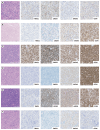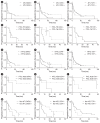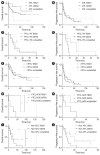Clinicopathological implications of immunohistochemical expression of TBX21, CXCR3, GATA3, CCR4, and TCF1 in nodal follicular helper T-cell lymphoma and peripheral T-cell lymphoma, not otherwise specified
- PMID: 38247153
- PMCID: PMC10948251
- DOI: 10.4132/jptm.2024.01.04
Clinicopathological implications of immunohistochemical expression of TBX21, CXCR3, GATA3, CCR4, and TCF1 in nodal follicular helper T-cell lymphoma and peripheral T-cell lymphoma, not otherwise specified
Abstract
Background: The classification of nodal peripheral T-cell lymphoma (PTCL) has evolved according to histology, cell-of-origin, and genetic alterations. However, the comprehensive expression pattern of follicular helper T-cell (Tfh) markers, T-cell factor-1 (TCF1), and Th1- and Th2-like molecules in nodal PTCL is unclear.
Methods: Eighty-two cases of nodal PTCL were classified into 53 angioimmunoblastic T-cell lymphomas (AITLs)/nodal T-follicular helper cell lymphoma (nTFHL)-AI, 18 PTCLs-Tfh/nTFHL-not otherwise specified (NOS), and 11 PTCLs-NOS according to the revised 4th/5th World Health Organization classifications. Immunohistochemistry for TCF1, TBX21, CXCR3, GATA3, and CCR4 was performed.
Results: TCF1 was highly expressed in up to 68% of patients with nTFHL but also in 44% of patients with PTCL-NOS (p > .05). CXCR3 expression was higher in AITLs than in non-AITLs (p = .035), whereas GATA3 expression was higher in non-AITL than in AITL (p = .007) and in PTCL-Tfh compared to AITL (p = .010). Of the cases, 70% of AITL, 44% of PTCLTfh/ nTFHL-NOS, and 36% of PTCL-NOS were subclassified as the TBX21 subtype; and 15% of AITL, 38% of PTCL-Tfh/nTFHL-NOS, and 36% of PTCL-NOS were subclassified as the GATA3 subtype. The others were an unclassified subtype. CCR4 expression was associated with poor progression-free survival (PFS) in patients with PTCL-Tfh (p < .001) and nTFHL (p = .023). The GATA3 subtype showed poor overall survival in PTCL-NOS compared to TBX21 (p = .046) and tended to be associated with poor PFS in patients with non-AITL (p = .054).
Conclusions: The TBX21 subtype was more prevalent than the GATA3 subtype in AITL. The GATA3 subtype was associated with poor prognosis in patients with non-AITL and PTCL-NOS.
Keywords: Angioimmunoblastic T-cell lymphoma; Nodal T-follicular helper (TFH) cell lymphoma, angioimmunoblastic-type; Nodal T-follicular helper (TFH) cell lymphoma, not otherwise specified; Nodal peripheral T-cell lymphoma of TFH phenotype; Peripheral T-cell lymphoma, not otherwise specified.
Conflict of interest statement
The authors declare that they have no potential conflicts of interest.
Figures




Similar articles
-
Comprehensive analysis of clinical, pathological, and genomic characteristics of follicular helper T-cell derived lymphomas.Exp Hematol Oncol. 2021 May 14;10(1):33. doi: 10.1186/s40164-021-00224-3. Exp Hematol Oncol. 2021. PMID: 33990228 Free PMC article.
-
Distinct and overlapping features of nodal peripheral T-cell lymphomas exhibiting a follicular helper T-cell phenotype: a multicenter study emphasizing the clinicopathological significance of follicular helper T-cell marker expression.Hum Pathol. 2023 Jan;131:47-60. doi: 10.1016/j.humpath.2022.12.003. Epub 2022 Dec 8. Hum Pathol. 2023. PMID: 36495942
-
Comprehensive comparison of international prognostic indexes for follicular helper T-cell lymphoma.Ann Hematol. 2022 Jul;101(7):1535-1543. doi: 10.1007/s00277-022-04805-y. Epub 2022 May 31. Ann Hematol. 2022. PMID: 35639152
-
Classification and diagnostic evaluation of nodal T- and NK-cell lymphomas.Virchows Arch. 2023 Jan;482(1):265-279. doi: 10.1007/s00428-022-03412-6. Epub 2022 Oct 10. Virchows Arch. 2023. PMID: 36210383 Review.
-
The new biology of PTCL-NOS and AITL: current status and future clinical impact.Br J Haematol. 2020 Apr;189(1):54-66. doi: 10.1111/bjh.16428. Epub 2020 Feb 17. Br J Haematol. 2020. PMID: 32064593 Review.
References
-
- Swerdlow SH, Campo E, Harris NL, et al. WHO classification of tumours of haematopoietic and lymphoid tissues. Revised 4th ed. Geneva: World Health Organization; 2017.
-
- Vallois D, Dobay MP, Morin RD, et al. Activating mutations in genes related to TCR signaling in angioimmunoblastic and other follicular helper T-cell-derived lymphomas. Blood. 2016;128:1490–502. - PubMed
Grants and funding
LinkOut - more resources
Full Text Sources

